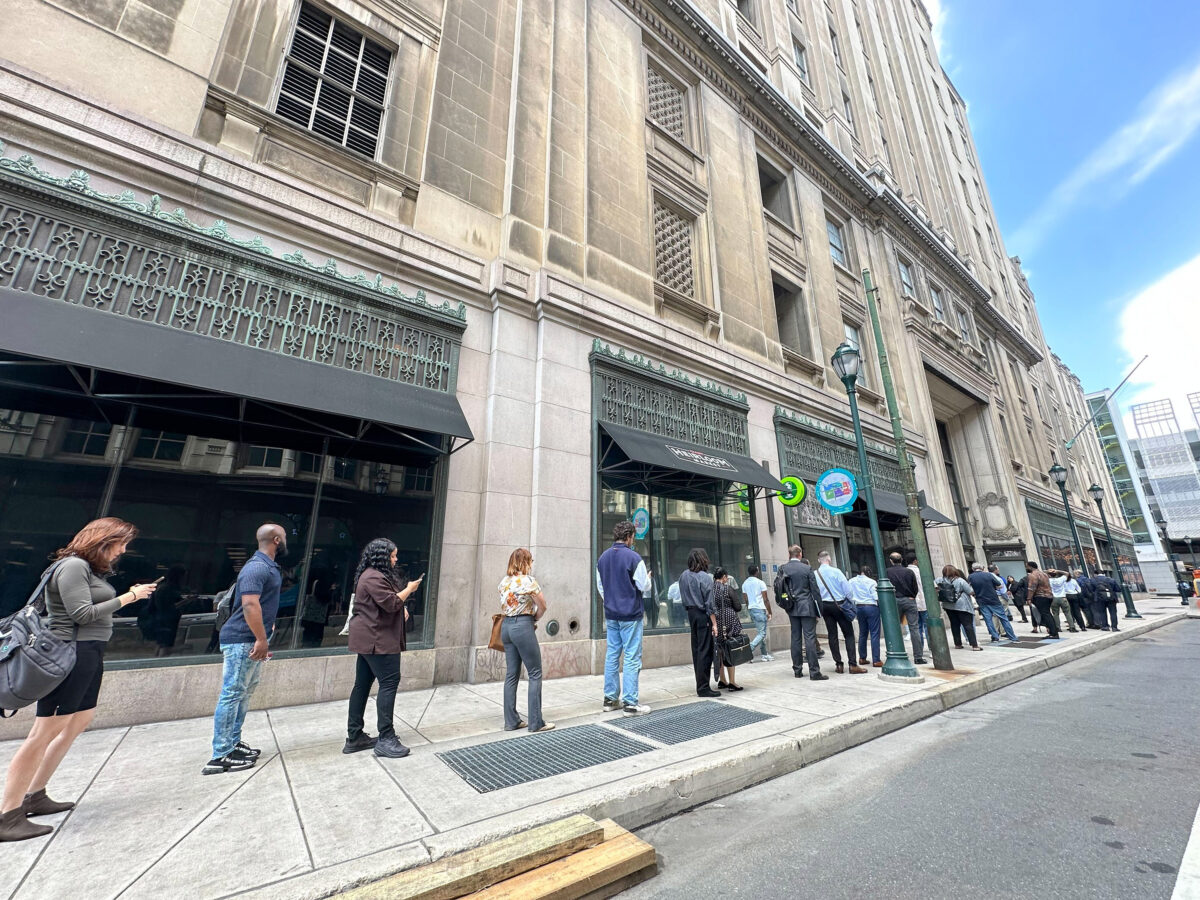At Technical.ly’s NET/WORK jobs fair in Philadelphia this week, there was a line to get in that stretched around the block. Upstairs, the room was packed with aspiring software devs and others seeking to break into the industry.
Meanwhile, the cohort of hiring companies was smaller than pre-pandemic years — and not offering many early-career positions, according to some job-seekers.
“You go to all of these booths and they’re looking for ‘head of department this’ or ‘senior-level that,’” said attendee Alex Ramos, who graduated from college in 2021. “There are no entry-level positions. Each place has like maybe three openings, and most of them are senior level.”
Even when there are positions open, the requirements can seem paradoxical.
“I feel like entry-level jobs now require ridiculous amounts of experience,” one early-career software engineer told Technical.ly, asking to remain anonymous to avoid jeopardizing future job prospects. “I wish there was a system that actually filtered for entry-level roles.”
Data sourced from LinkedIn in January backs up the sentiment.
Across several hundred job listings resulting from a query for “entry-level software engineer” in the Philly area, the average minimum experience required was 4.5 years.
A layoff-saturated market without geographic constraints
How did this situation arise? Aggressive overhiring during COVID to serve a population suddenly forced into online-only work, school and other activities, tech recruiter Greg Zazzarino told Technical.ly. Post-lockdown, consumer demand for internet services fell — just as the so-called “cheap money era” of zero interest rate policy came to an end,
Companies responded with massive staff cutbacks. There were over 262,000 layoffs in the IT sector in 2023, according to NerdWallet, a jump of 60% from the previous year. The only comparable year with such a rapid pace of tech firings was two decades ago: in 2001, when the dot com bubble dramatically burst.
This resulted in a supply and demand imbalance, with an oversaturation of developers who’d been hired during COVID and then laid off.
The hiring environment shifted from being essentially a “buyer’s market” where candidates had their pick of the litter, Zazzarino said, into a “seller’s market,” where companies had the upper hand.
Remote work only added to the competitiveness, as the candidate pool for each position was not geographically constrained.
That geographic freedom also applies internationally. American software developers are more expensive than devs in many other countries, and junior positions are the most susceptible to this trend. The average salary of a developer in London is around $66,000, according to data reported by the Wall Street Journal, versus about $175,000 in New York City and $106,000 in Cleveland.
Signs of a turnaround in the data?
Good news for people trying to get hired, though: Winds may be shifting.
Anecdotally, people at the NET/WORK jobs fair still felt the pinch. Though they were glad to get their free headshots and meet people, two nursing professionals looking to break into tech told Technical.ly they hadn’t found any applicable positions.
But the data is showing what looks like signs of turnaround. In April, the same LinkedIn query from January returned very different results.
Instead of 4.5 years, the average minimum experience required in the job listings was just 2 years. This was true not just in the Philadelphia region but across several US metro areas.
The mini-reversal of the trend is borne out by national data. The number of new job openings per day in public software companies has ticked up since the start of 2024, according to reporting from Bloomberry, suggesting that hiring for may be beginning to return.
Tips for getting hired anyway
Despite these headwinds, there are ways to get your foot in the door. An entry-level or early-career developer needs to do more than hit the “Apply” button on a website to get ahead.
One of the key activities a developer can engage in is networking, Travis Southard, co-director of Code for Philly, told Technical.ly: “People get jobs by talking to people.”

Sedia Massaquoi and Faith Sarnor at the 2024 NET/WORK jobs fair during Philly Tech Week (Danya Henninger/Techincal.ly)
Participating in community-benefitting, open-source projects like the one Southard runs are another effective way to stand out. It’s important for a developer to know how to work with other people, given that it is a critical skill that is not always taught well. Code for Philly lets developers find projects to work on collaboratively. Locating an open source tech tool that is growing and contributing to a code base is another way to go about this.
Presenting well online is another factor that can improve the chances of getting a role, according to Zazzrino, the tech recruiter.
This includes presenting a strong portfolio and an optimized LinkedIn profile. A developer should ensure that the basic things are filled out, such as a photo, having an adequate summary, and including appropriate keywords in the description. If these basic things aren’t filled out, Zazzarino said, the profile simply won’t show up to recruiters.
Before you go...
Please consider supporting Technical.ly to keep our independent journalism strong. Unlike most business-focused media outlets, we don’t have a paywall. Instead, we count on your personal and organizational support.
3 ways to support our work:- Contribute to the Journalism Fund. Charitable giving ensures our information remains free and accessible for residents to discover workforce programs and entrepreneurship pathways. This includes philanthropic grants and individual tax-deductible donations from readers like you.
- Use our Preferred Partners. Our directory of vetted providers offers high-quality recommendations for services our readers need, and each referral supports our journalism.
- Use our services. If you need entrepreneurs and tech leaders to buy your services, are seeking technologists to hire or want more professionals to know about your ecosystem, Technical.ly has the biggest and most engaged audience in the mid-Atlantic. We help companies tell their stories and answer big questions to meet and serve our community.
Join our growing Slack community
Join 5,000 tech professionals and entrepreneurs in our community Slack today!

The person charged in the UnitedHealthcare CEO shooting had a ton of tech connections

Delaware students take a field trip to China using their tablets and ChatGPT

From rejection to innovation: How I built a tool to beat AI hiring algorithms at their own game





